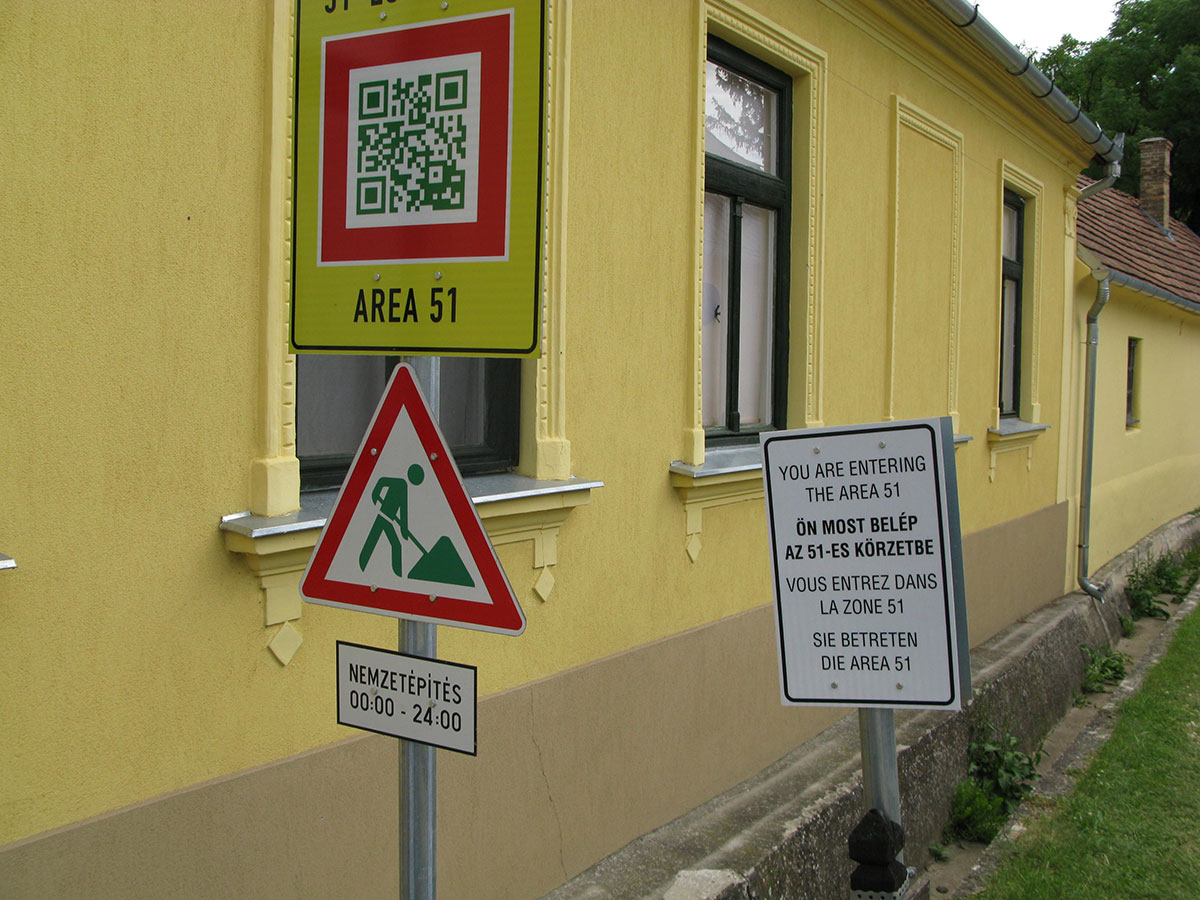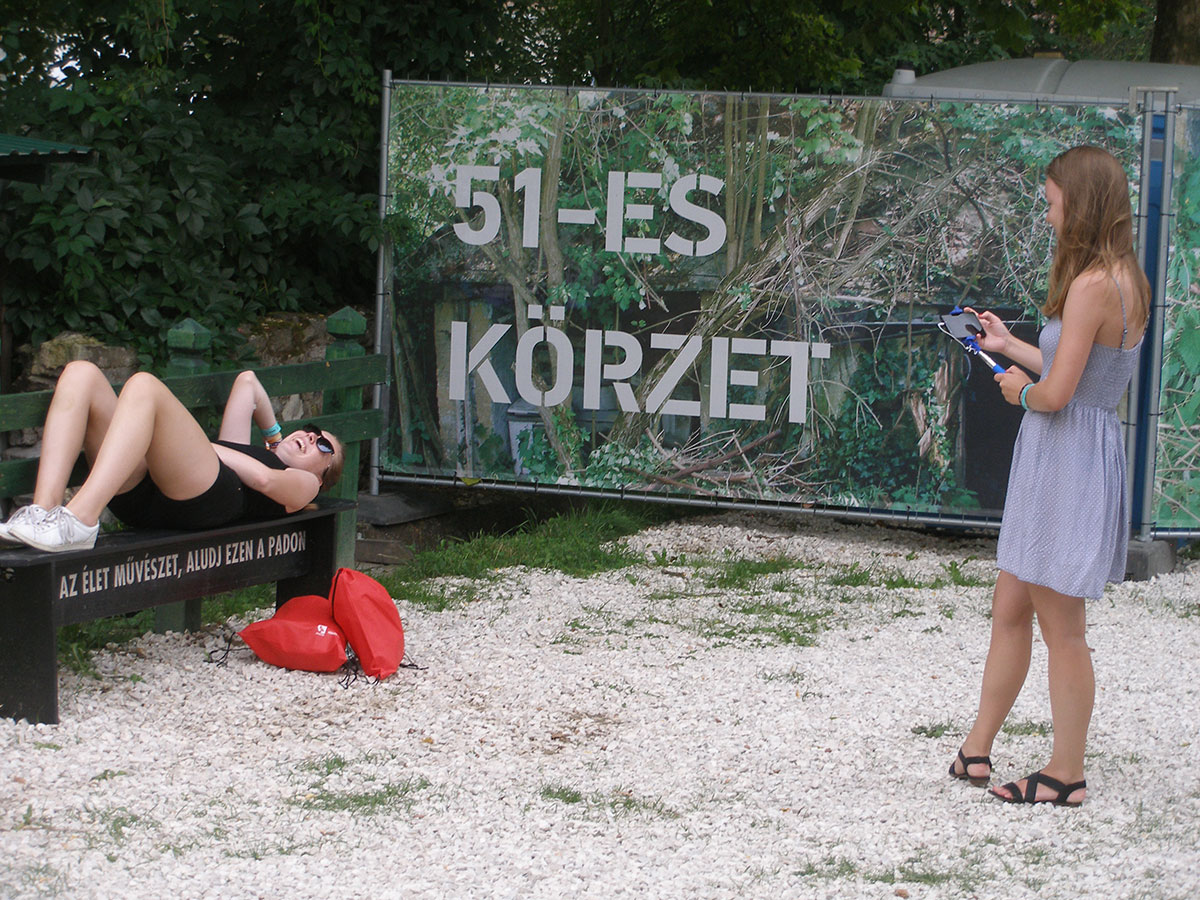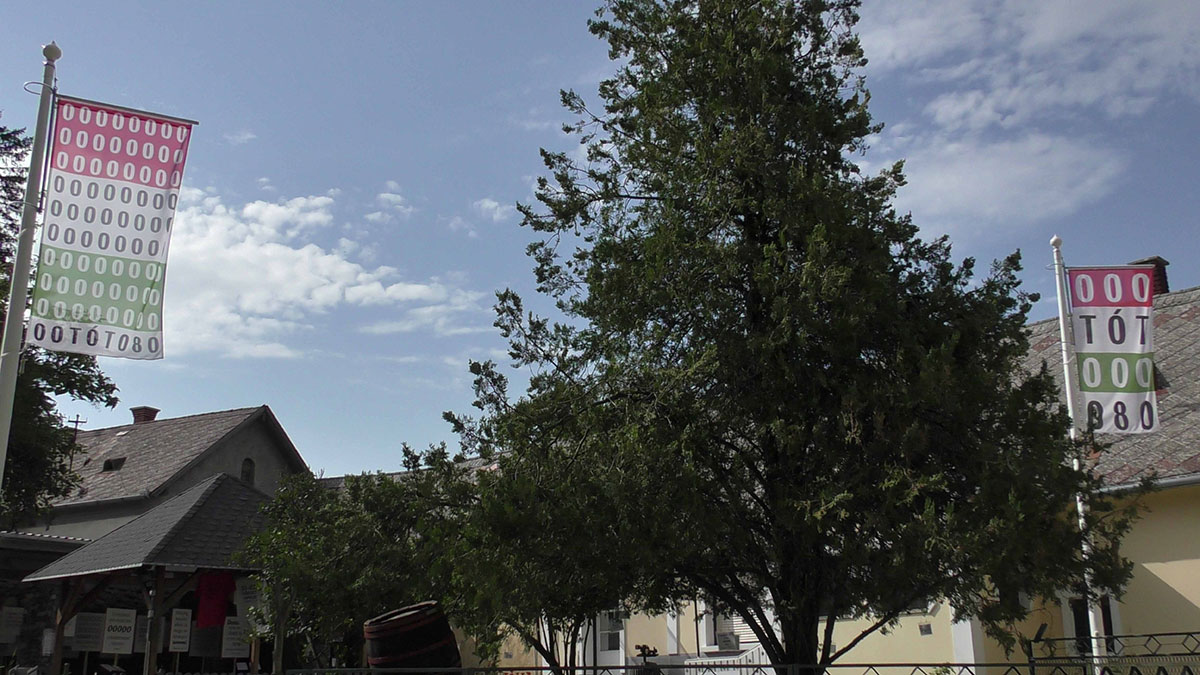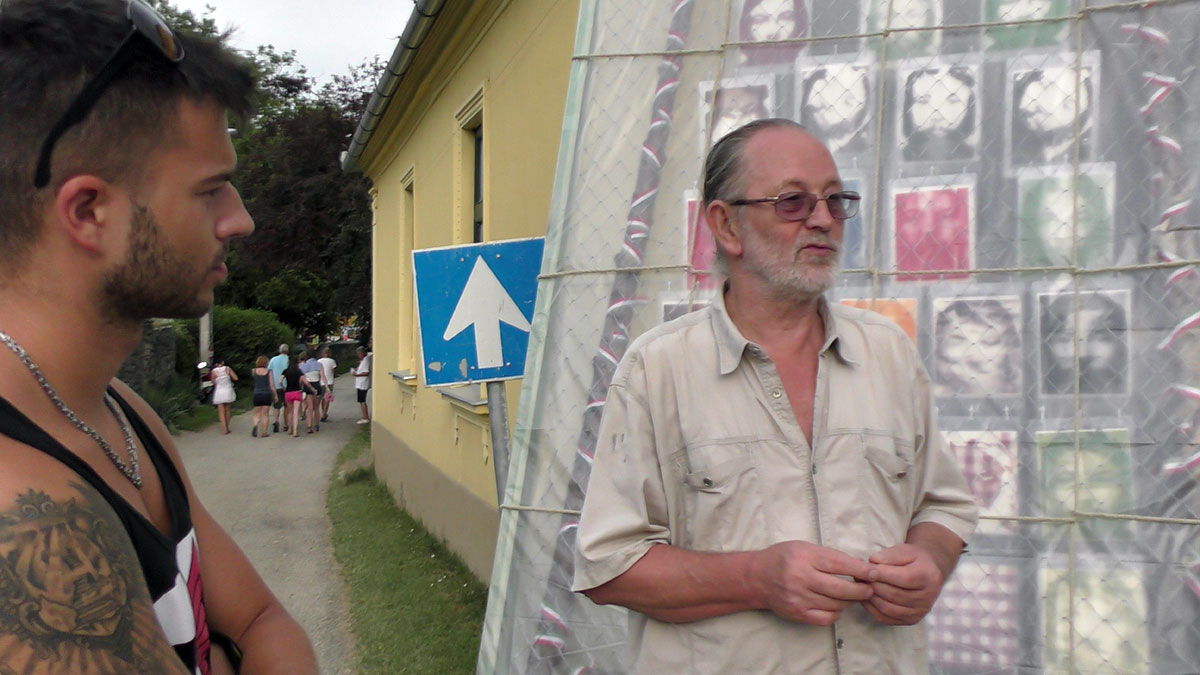Given the declining number of fine arts events at the Kapolcs summer festival[1], Artpool has been a refreshing exception and a reliable presence here for years, guaranteeing intellectual excitement for visitors.
In 2017, following the practice of preparatory projects[2] presented in previous years, fine artist György Galántai implemented his Active Archives[3] concept; using the documents in Artpool’s archives he created a complex curatorial project, a multidimensional work reflecting upon the milieu of the Kapolcs festival and standing out in the festival’s environment. The end result, which many of the visitors were able to experience in person, is impossible to convey through this article, which is why in the following you can read the general description and the important background information linked to the project.
The space previously occupied by Artpool’s exhibitions in Kapolcs was enlarged this year: the key location for the event was the so-called Area 51, in the centre of the village, next to the K55 exhibition space (Galántai house) and comprising the buildings and garden at 51 Kossuth Street as well as the little cul-de-sac between the two venues. For the time of the exhibition the street was – not incidentally – renamed ‘Tót Endre Street’. (The Fluxus practice of renaming streets is well known from the activity of both Artpool and Endre Tót.[4]

Tót Endre Street
The complete photographic and audio documentation of the event can be found at https://www.artpool.hu/K51/2017/ and https://www.artpool.hu/K55/2017/

Area 51
The signs marking the boundary of Area 51, reminiscent of the Checkpoint Charlie signs in Berlin, conveyed clearly, in four languages, to all visitors that they were crossing a boundary both physically and symbolically.
Upon entering the area, benches inscribed with lines about the connection between art and life, actually originating from Artpool’s Ben Tér [Ben Square] project, were set up at both corners of the street for anyone who wanted to take a rest. The unexpected inscriptions – “If life is art, what is the need for art?” and “If life is art, sleep on this bench” – first somewhat confounded but then inspired visitors: the location turned into a favoured site for photographs and ‘obeying the command’ written on one of the benches, many people took a nap on it.
The next surprise was the musical atmosphere distinct from the overall bustle of the festival: approaching the scene from one direction, one was greeted by madrigals and Gregorian chants, while arriving from the other, the sound of African drums and TEDx lectures were coming from hidden loudspeakers. The QR code, which provided more detailed information, and the sounds emitted by a mysterious source (re-enforcing the notion of the original Area 51, i.e. the US military base carrying out secret experiments on aliens) not only aroused historical associations but also expanded the semantic space of interpretation into science fiction. The large poster filling the entire expanse of the wall of the Galántai house contained Galántai’s credo on the influence of the ever-increasing volume of media exerted on people. His lines evocative of Vilém Flusser could be interpreted as a kind of instructions for use: “People learn to read texts, images and sound together (...) puzzle-solving reading is replaced by computing (assembling) reading, which slowly transforms every previous code.”[5]

TÓT 80, tricolour zero flags
The text and the “TÓT 80” tricolour zero flags flanking the entrance to the garden opposite prepared visitors for the experience they were about to partake in: upon entering they found themselves in a multi-sensor installation, which simultaneously appealed to their hearing and vision, their body, mind and spirit. The spacious garden, the covered yard, the shed as well as the old peasant house overgrown with ivy and the cellar functioned as exhibition venues.
Using a combination of media, the exhibition explored its central motif – ‘nothing’ – which also worked as a reference point. The walls, buildings and objects bore quotations linked to the theme of ‘nothing’ that fit in with the given environment and resonated with it. Some of these texts were placed on signs similar to those used earlier for Artpool’s Liszt Ferenc Square open-air exhibitions, such as the one that formed part of the Laza szlogenek [Loose Slogans] project[6] of 1994. Ideas linked to ‘nothing’ communicated messages digestible for the festival-goers: wandering among the signs, they were able to discover and record the nothing-quotations addressing them. Source texts key to Artpool’s operation and philosophy, texts by Miklós Erdély[7] and György Galántai[8], were pasted on two additional large posters as curatorial wall captions.

Nothing-quotes
The philosophical-conceptual approach that characterises the curatorial projects implemented in Kapolcs in a way that fully exploits the advantages of the local environment is also easy to understand by visitors who come here less frequently. Nothing-research came out of an earlier interest of Galántai’s, who had turned to the theme in the 1970s and included it in several of his Artpool projects: for example, he explored the theme of nothing based on texts by Yves Klein, Ben Vautier, Ray Johnson, Miklós Erdély and Endre Tót in the exhibition in March 1999 titled Kontextus nullpontok – A monokróm és a semmi [Context Zero Points – Monochrome and Nothing][9] (in the Artpool P60 exhibition space). Protest placards is another one of Galántai’s old interests: he made placards for the demonstrators in 1956 (the retaliation that followed defined his fledgling artistic career). His protest placard titled Mirror (1989) made for the Berlin wall is integrated in the present exhibition and – integrated as a design element – it re-enforces the protest placards installed in the covered courtyard.
![György Galántai's Tükör [Mirror] protest placard, 1989 / 2017](kepek/balkon10.jpg)
György Galántai's Tükör [Mirror] protest placard, 1989 / 2017
The multimedia project titled Tüntetés / kitüntetés / semmi [Demonstration / Award / Nothing] is at once a site-specific installation and a Fluxus musical space. The nothing-quotes taken from various sources and characterised by a thematic diversity were the result of online collecting work, which was assessed by Artpool’s staff upon Galántai’s request: the quotes that received the most votes were put on the placards . Quotes from Aristotle, Albert Einstein, Dezső Tandori, Béla Hamvas, Lajos Kossuth, Martin Luther King and others were printed in various sizes and pasted on placards, trees, objects and walls. Although there was no hierarchy among the selected quotes, the spatial arrangement of the texts followed a logic. The quotes that worked well in crowds, as advertising slogans, and those with social relevance – each with a different typography and visual design – were placed on two-sided protest placards suspended in the covered courtyard. The aphorisms with a more personal tone inviting visitors for contemplation could be read on labels hung on the trees in the garden, while more universal nothing-interpretations were put on the walls, doors, window frames and objects.
Those reading the texts and walking through this space encountered various audio environments: thirteen musical experiences– some of them originating from surprising sources (e.g. electric meter, underground shaft, monument toilet, attic, cellar, etc.) ranging from opera and Indian mantras through bird sounds and blues to dubstep and trap. These sound effects added a contextual integrity to space and guided visitors from one location to the next. The seemingly ad hoc space-sound installation was actually based on well thought-through curatorial decisions and created a complex and continuously changing musical experience, that of a ‘flowing space’. The unusual visual environment combined with the special sound effects created an island, a meditative space away from the festival’s buzz, where the nothing-texts could be contemplated. Stepping out of the covered courtyard and entering the shed, visitors arrived in the Nothing-cinema, where a selection of music clips, linked to the previous sound cultures, also addressed the universality of nothing. This collection was a kind of ‘cultural rubbish dump’ with at times unexpected sound sequences and ideas. We found ourselves amidst shocking life-worlds and subcultures in this space, while returning to the protest placards hanging in the covered courtyard, the nothing-quotes felt like ricocheting and opening up philosophical profundities. The installation engaged in a peculiar dialogue with nature. A garden always stands at the boundary of nature and culture: it is a piece of cultivated wilderness, which at times imitates the irregularities of nature and at other times impresses viewers with its well-constructed design. Area 51 further underlines this boundary situation: the buildings, along with the objects scattered around the garden, (grape grinder, grape press, barrels), can be seen as the marks left by the activities of mankind cultivating nature and exploiting its resources to his own benefit. At the same time, nature and decay have apparently been reclaiming this area step by step for years, making headway by leaving behind collapsed walls, moss-covered bricks and walls overgrown with ivy. The time-layers towering on top of one another release observers from the present time, from everyday reality.
Nature formed part of the installation in another context too: the weather conditions in Kapolcs created a changing environment for the exhibition, creating new situations and making chance a co-artist. Those who were part of the greatest storm of the festival week, for example, had a unique experience. The raging rain and the curtain of mist enveloping the hill rising up behind the village made the concept of majestic into a palpable experience, especially for us, who, – thanks to György Galántai’s invitation – were in the underground sound coulisse, from where an opera aria was playing. In the meantime, the covered space with the placards was lit like a stage and had some music stands, thus creating the impression of a performance without performers, and evoking the atmosphere of post-human theatrical performances and performance art events. The garden showed a completely different face at bright noon and at dawn, when we looked up from the bottom, or across from the side; it was this special experience that made many visitors keep returning to the exhibition scene.
Similarly to the advertising action[10] of 1971 in Balatonboglár, visitors had the opportunity to stencil T-shirts printed with the words “Area 51”, choose one of the exhibited two-sided placards and join a spectacular and tumultuous advertising demonstration that proceeded through the bustle around Area 51. These demonstrations can be interpreted in connection with Endre Tót’s zero demonstrations, including the one titled Zer0-demo, the recording of which was screened at the exhibition. The nothing-texts on the back panels of the zero-placards introduced a new twist, which was not present at the Endre Tót demonstrations: instead of a nihilistic nothing, they propagated the notion of a meaningful nothing. The procession with zero placards called attention to the fact that demonstrations can be appropriated and hi-jacked; depending on different geopolitical situations, this aroused/arouses various associations: it had a different meaning in the nineties in Oxford, in 2013 in Budapest, and in 2017 in Kapolcs. Here and now, it made some participants burst out with laughter and make good-humoured comments, while it brought a conspiratorial smile to others’ faces. The Kapolcs demonstrations can actually be seen as an extension of the Area 51 exhibition, as a living advertisement and a demonstration of existence, but, vice versa, the displayed protest placards can also be regarded as relics or still props for a performance. The room, kitchen and attic of the Borostyánház [literally: ivy house] as well as the cellar – which was newly opened as a venue for Area 51 – served as the exhibition space paying tribute to Endre Tót, who celebrates his 80th birthday this year, and provided the context for the Nothing placards. In the vaulted cellar inscribed with the line “Rise, Hungarian Underground”, visitors could see Endre Tót’s little nothings intended to bring delight (I’m glad if I… series of images and video), along with Galántai’s thematically related glass protest placard titled Kézzelfogható, nemzeti és átlátható [Tangible, National and Transparent, 2015].
![Talpra magyar underground [Rise, Hungarian Underground] | Detail from the exhibition](kepek/balkon27.jpg)
“Talpra magyar underground” [“Rise, Hungarian Underground”] | Detail from the exhibition
On the kitchen wall in the ‘ivy house’ hung Tót’s “empty pictures”. Looking in through the wide chimney door, we could watch Endre Tót’s life interview on a TV screen. Tót’s zero works were displayed in the room and accompanied by the sound of birds chirping coming from the cellar. In the attic, the video of the Budapest zer0-demo demonstration was playing, with the sound of Indian mantras in the background. The interlaced exhibitions complemented each other, combining into an integral whole, with Tót’s zero works[11] providing the backdrop for the nothing placards. Tót’s interest in nothing and his use of zeros defined his entire oeuvre. He debuted with his first zero works (e.g. transfer slip 0, i.e. issued to zero forints; and a letter whose envelope contained only the details of the sender, the name of the addressee and 0s) at the 1971 biennial in Paris. In the next year, he implemented zer0-typing actions at several locations and after the end of the related exhibition he sent the sheets with hundreds and thousands of zeros written over them to every corner of the world (action + exhibition + Mail Art in one). He organised the first Zero demonstration – based on the street actions he had been implementing from the mid-seventies – in 1980, in Viersen.
In his two-sided protest placards , György Galántai displayed the relation between “nothing” (concept) and “zero” (number). Zeros stand for the meaninglessness of life, while the “nothing” texts on the back of the placards – as if offsetting the zeros – express the meaning of life. Hence, zero becomes nothing and nothing becomes something. This same idea was made tangible in space in the installation in Area 51 in Kapolcs, in the form of the nothing-texts and the meditative style sound environment.
“Award”, i.e. the third thematic element of the curatorial concept, was realised in the Galántai house (K55), which has been home to various Artpool projects since the early 1990s. The visual design of the portal functions as the opening image of the Kapolcs exhibition every year. This time György Galántai’s large assemblage titled Kitüntetéseim [My Awards, 1976–2017] was propped against the wall, before the entrance to the house.
Galántai’s work was set up in a tent-like fashion, behind which visitors were able to read Miklós Erdély’s text titled Kitüntetéseimről[12] [On My Awards] all day, which was enlarged and printed on a molino and whose audio version was playing from an archive recording.
The exhibition, open in the evenings, included works and video documents reflecting upon the theme of the social rite of presenting awards: award-works (e.g. Miklós Erdély, Gábor Tóth); awards by fictitious institutions and fictitious art projects (e.g. “certificate with a DADAMA awarding application, 2009”, “TRIPICON honorary citizen certificate, 1985”, János Major Award, Miki Mécs Award, daily award of the For National Art Foundation); underground art awards (e.g. Kassák Award and Catalyst Award). The main message of the exhibited works was to show how art awards and prizes virtually always, verge on the absurd, in every political system. Miklós Erdély’s scathingly ironic writing titled Kitüntetéseimről [On My Awards] paints the distorted picture of how the subjects in any system adapt to power; the closing line make an especially strong point: “For the moment, despite all my precautions, and efforts at disinfecting and conservation, my hard-earned secret awards regrettably start running and, accompanied by my barely surpassable sense of shame, they trickle into my pants one after the other.” A similarly critical idea was expressed about government awards by Herbert Marcuse, who thinks that “obscene is not the picture of a naked woman who exposes her pubic hair but that of a fully clad man who exposes his medals rewarded in a war of aggression”[13]. Indeed, the acceptance of violence and power, which Erdély heavily criticised, was present on both sides of the iron curtain at the time. Galántai’s ironic Díj-csapda [Award-trap, 1977] fits in well with Erdély’s text, while his humorous self-award works, such as his large mirror-work titled Mindenki kitüntetése [Everybody’s Award, 2015] and Kitüntető eszköz [Awarding Device, 2017] provide humorous counterpoints to Erdély’s writing. The awarding device is a plasma sphere that awards everyone who touches it, i.e. it democratises and thus dissolves the cultic respect for awards.
Instead of the cool certainty of an exhibition hall, the Tüntetés / Kitüntetés / Semmi [Demonstration / Award / Nothing] project undertook the risk of being exposed in a public space and, utilising the conceptual structures of Artpool’s research area, it realised a new curatorial concept of arrangement to create a 21st-century art presence.

György Galántai
© Photos: György Galántai, Dóra Halasi, Júlia Klaniczay – Artpool Art Research Center
To quote Galántai: “New art tends to come into being when it presents a new structural concept, which enables the rearrangement of what is already familiar, and while integrating some previous inventions, it eliminates certain others.”[14]
[2] Szubjektív/objektív [Subjective/Objective], 2016; Ben Vautier 80, AMT Alternatív Művészeti Tér [Alternative Art Space], 2015
[3] Galántai György: Aktív Archívum [Active Archives], 1979–2003
[4] For example, the Ben TER project of 1993 (images at https://www.artpool.hu/Fluxus/Ben/TER/2-1.html) and the appearance of the street sign as a new medium at Endre Tót’s exhibition in Szombathely in the same year
[5] Galántai György: A vándorló nullpontok kontextusa [The Context of Wandering Zero Points]
[6] Laza szlogenek [Loose Slogans], Szabadtéri feliratok a Liszt Ferenc téren [Open-air Inscriptions on Liszt Ferenc Square], 24 September – 9 October 1994
[7] Miklós Erdély: Aranyfasisztáim [My Golden Fascists], 1985
[8] György Galántai: A “semmi” konvenció [The ‘Nothing’ Convention (notes), Galántai Napló [Galántai Diary], 18 October 1975, in: Galántai – Életmunkák / Lifeworks 1968–1993, Artpool – Enciklopédia Kiadó, Budapest, 1996, p. 80. http://www.galantai.hu/diary/Conceptworks.html
[9] Kontextus nullpontok – A monokróm és a semmi [Context Zero Points – Monochrome and Nothing], Artpool-P60, 12–26 March 1999
[10] György Galántai: Reklám trikó akció [T-shirt Action], 1971, in: J. Klaniczay – E. Sasvári (ed.): Törvénytelen avantgárd. Galántai György balatonboglári kápolnaműterme 1970–1973 [Illegal Avant-garde. The Chapel Studio of György Galántai in Balatonboglár 1970-1973], Artpool–Balassi, Budapest, 2003, p. 56, https://www.artpool.hu/boglar/1971/710716e_a.html
[11] Endre TÓT, Zéró retrospektív [Zero Retrospective], (zéró-munkák [Zero Works] 1971–1984)
[12] Miklós Erdély: Kitüntetéseimről [On My Awards], 1974
[13] Herbert Marcuse: An Essay on Liberation, Boston, Beacon, 1969, pp. 7-8
[14] Galántai a művészetről [Galántai on Art], 2 January 1979, in: Galántai – Életmunkák / Lifeworks 1968–1993, Artpool – Enciklopédia Kiadó, Budapest, 1996, p. 44